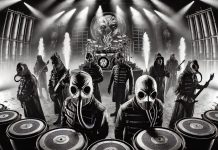Books and music frequently inspire one another, with numerous musicians drawing inspiration from renowned stories to craft exceptional songs. Bands such as Radiohead, Metallica, The Ramones, and Muse have transformed characters and themes from literature into musical masterpieces. In this article, we will explore iconic songs inspired by famous books, showing the creative fusion of these two art forms.
1. Paranoid Android by Radiohead
Drawing from the imaginative world of Douglas Adams’ renowned science fiction novel, The Hitchhiker’s Guide to the Galaxy, Radiohead’s “Paranoid Android” embodies the book’s peculiar and profound themes. The song’s intricate melodies and thought-provoking lyrics mirror the surreal and intricate universe Adams crafted, offering listeners an intriguing glimpse into its captivating depths.
2. One by Metallica
Dalton Trumbo’s renowned anti-war novel, written in 1939, tells the story of a young soldier severely injured in the First World War. He loses his arms, legs, eyes, tongue, and face, but his mind remains conscious, leaving him trapped in an unresponsive body to ponder his fate.
The novel was adapted into a powerful film in 1971, a time when the Vietnam War kept the story’s themes acutely relevant. In 1988, Metallica drew inspiration from the novel for their song “One,” incorporating clips from the film into their music video.
As you might have already guessed, you can learn more about book songs after reading the originals. These do not have to be physical books; you can use online novels. Although Trumbo’s remarkable life was later portrayed in a 2015 biopic starring Bryan Cranston of “Breaking Bad” fame, if you read the book, you can find out many more interesting details. Whatever you are looking for, you can use the novels app from FictionMe.
3. Frankenstein by Lenny Kravitz
Drawing profound inspiration from Mary Shelley’s 1818 novel, Lenny Kravitz’s “Frankenstein” narrates the tale of a man yearning for love and forgiveness amidst misunderstanding. Although Kravitz’s song perpetuates the common error of naming the monster Frankenstein instead of its creator, the song’s message remains unequivocal. The protagonist in the song parallels himself with Frankenstein, feeling both broken and manipulated, yet unwavering in his pursuit of love and understanding.
4. Gravity’s Rainbow by Klaxons
Before “Gravity’s Rainbow” became an iconic Nu Rave indie dance floor anthem, it was originally a 1973 novel penned by American author Thomas Pynchon. Often hailed as one of the most significant American novels ever written, the book intricately weaves together themes of science and speculative metaphysics with elements of both high and low culture—a blend that, in retrospect, aligns perfectly with the Nu Rave aesthetic.
5. Yertle The Turtle by Red Hot Chili Peppers
“Dr. Seuss isn’t exactly rock ‘n’ roll material, you say? Los Angeles’ beloved funk rock band couldn’t care less about that opinion. This track from their second album, Freaky Styley, demonstrates that the whimsical randomness of Theodor Seuss ‘Ted’ Geisel’s stories aligns perfectly with the Chili Peppers’ early experimental vibes. Just imagine if they turned this idea into an entire concept album featuring classics like The Cat in the Hat, Green Eggs and Ham, Horton Hears a Who, and How the Grinch Stole Christmas. We’d pay top dollar to hear that!”
6. I Am The Walrus by The Beatles
The title of John Lennon’s whimsical creation from 1967 alludes to Lewis Carroll’s poem “The Walrus and the Carpenter,” found in the 1871 book Through the Looking Glass.
Furthermore, at the conclusion of the track, excerpts from a BBC radio adaptation of Shakespeare’s King Lear are featured, including: “If ever thou wilt thrive, bury my body; / And give the letters which thou find’st about me / To Edmund Earl of Gloucester; seek him out / Upon the British party: O, untimely death!”
7. Goodbye Yellow Brick Road by Elton John
Elton John’s “Goodbye, Yellow Brick Road” narrates the journey of an individual seeking to abandon a life of wealth and opulence in favor of simplicity and authenticity. While the song’s title pays homage to L. Frank Baum’s classic novel, “The Wizard of Oz,” direct references to the book within the lyrics are minimal. In the song, the yellow brick road symbolizes an affluent lifestyle marked by luxury and extravagance, akin to the road’s purpose in Baum’s story, which leads to the Emerald City.
One could also interpret the song’s opening verse as drawing inspiration from the novel, with mentions of a farm and the lines “When are you gonna come down? When are you going to land?” These could be seen as allusions to Dorothy’s descent following the cyclone that transports her to Oz.
Conclusion
Books are a source of inspiration for everyone: writers, performers, boxers, film directors, so it is not surprising that many songs have been created based on them. If among the listed works there are those that you like, you can also read the book and get more interesting details, and also get a better feel for the song.









